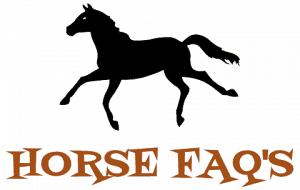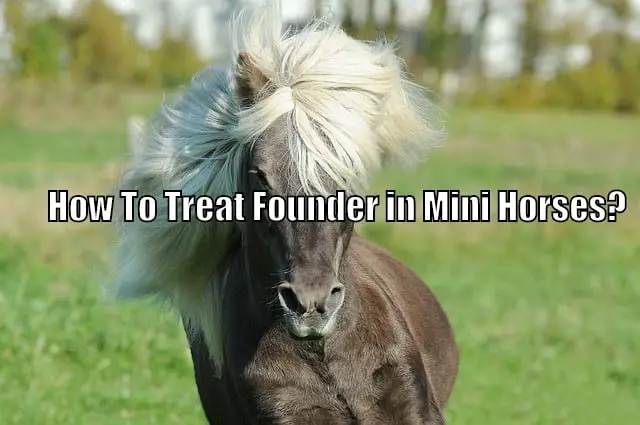Diseases and illnesses can be a hard thing to deal with whether happening to a person or an animal. It’s a sad and challenging process, but you have to stay strong and help the person or animal in need of assistance first and make sure that they are comfortable. Diseases and conditions also occur in horses, and a kind of problem that miniature horses have to face is the founder.
So, how to treat Founder in miniature horses? If your mini is going through founder, then it’d be an upsetting time for you but don’t worry as there are many cures and treatments there for its today of therapy. So stay strong and keep reading to know more about this condition and its medications.
What is Founder?
The founder is a painful inflammatory condition which involves the horse’s laminae. The founder is also called laminitis. Terms “laminitis” and “founder” are used interchangeably. Founder mostly refers to the chronic long-term condition in which rotation of the coffin bone indicated. Laminitis refers to an acute situation which occurs suddenly causing pain and inflammation of the laminae. Laminae are the tissues present between the wall and coffin bone of the foot.
The founder can happen in all 4 feet, but it usually occurs in front feet. In this condition, the laminate comes off and detaches from the coffin bone causing it to slip. It diverts towards the growing exerted on the sole of the feet. This causes pain and injury. It also causes fever and trembling of the muscles of the horse.
When the inflammation is mild, then there is no further risk to the health of the horse. In case of cell death that occurs at a higher rate leads to the destruction of the interlocking bond between the hoof wall and coffin bone. The coffin bone will start to rotate which will cause health hazards.
Causes of Founder:
A founder is an inflammatory condition. Inflammation occurs due to lack of blood flow in the laminae. When blood supply doesn’t reach the laminae, then the laminae are deprived of nutrients and oxygen. This causes the death of laminae tissues. The causes of laminitis are as follows:
1) Obesity: Overeating is one of the leading cause of founder in horses.
2) Overfeeding: When horses are feed more than enough amount of soluble carbohydrates it causes accumulation of undigested starch and sugars.
3) Equine metabolic syndrome: It also a cause of founder. This syndrome usually occurs after a fever.
4) Cushing’s disease: It is a hormonal disease. The pituitary gland is involved in this condition. It disturbs the hormones and causes hunger, thirst, sweat and weight loss.
5) Hard exercise: If the horse undergoes hard physical activity for a long time then it can create his founder condition.
6) Infections: Bacterial infections when occurring at a severe level can cause poisoning in the blood. This causes founder.
7) Stress condition: Stress is also a cause of founder in horses. Stress can be due to hard physical activity, travelling or when the environment for the horse changes.
Symptoms of Founder:
Signs and symptoms that indicate that a miniature horse has founder are as follows,
1) Lameness which is the abnormal stance of the horse due to dysfunction of the horse’s feet.
2) Difficulty in walking or in even moving around.
3) Facing problem in moving and rotating pedal bone.
4) Feeling exhausted which results in resting and often laying down.
5) Becomes hard for the horse to do any activity which involves the leg. Even lifting the leg causes pain.
6) Since feet become injured, so it feels painful even to walk or stand.
7) The horse stands with front legs out in front of their bodies.
How to treat Founder?
Just like most diseases founder can be treated by medication, therapy or surgery.
Medicines prescribed: NSAID (a non-steroidal anti-inflammatory drug) will given to the horse suffering from the founder. NSAID will be given to stop inflammation and relieve pain. If a founder is due to infection, then antibiotics are prescribed. Since blood flow in the feet was poorly affected, anticoagulants and vasodilators are given to the affected ministry horse to maintain blood pressure when improving the blood flow.
Surgery: Surgery is also an option if the condition is severe and the state of the horse is not getting better in other ways. Surgery can be done on deep digital flexor tenotomy or hoof wall research.
Cold therapy: In this therapy, the horse’s feet are soaked in cold water for at least 72 hours. Ice has to be replaced after a particular time to keep the foot below 40 degrees Fahrenheit.
Dietary plan: The veterinarian will ask to stop feeding the horse grain-based feeds and pasture. Only grass hay should be supplied.
Fluid administration: The horse is required to intake vast amounts of fluids in case of dehydration.
Stabling the horse: The miniature horse made to stable in soft ground such as sand. When the horse lays down on, and then the pressure decreases on the affected laminae.
Preventive measures:
Preventative measures are a must in how to treat founder in miniature horses, and as we all know that prevention is better than cure, so it’s good to be careful when taking care of the small horse. Horses should be in healthy and active state and taking care of their hoof is of utmost importance. Horses should be introduced gradually to lush pasture. The horses should be not allowed to consume black walnuts. Too much grain should not add in the diet. Overfeeding should be avoided; otherwise, it might lead to obesity increases the risk for a founder. It should be made sure that a mare passes her placenta within 3 hours of foaling. If fever detected on the horse, it should be immediately taken care of otherwise it may lead to founder.
Reoccurrence of laminitis: When a miniature horse has recovered from laminitis there is a chance that it might occur again. So extra care should be taken of such horses especially. The diet should be full of nutrients. It should consist of digestible fibre and should be free from the excess amount of carbohydrates. Health maintenance should be the number one priority by injecting vaccines and parasite control.

